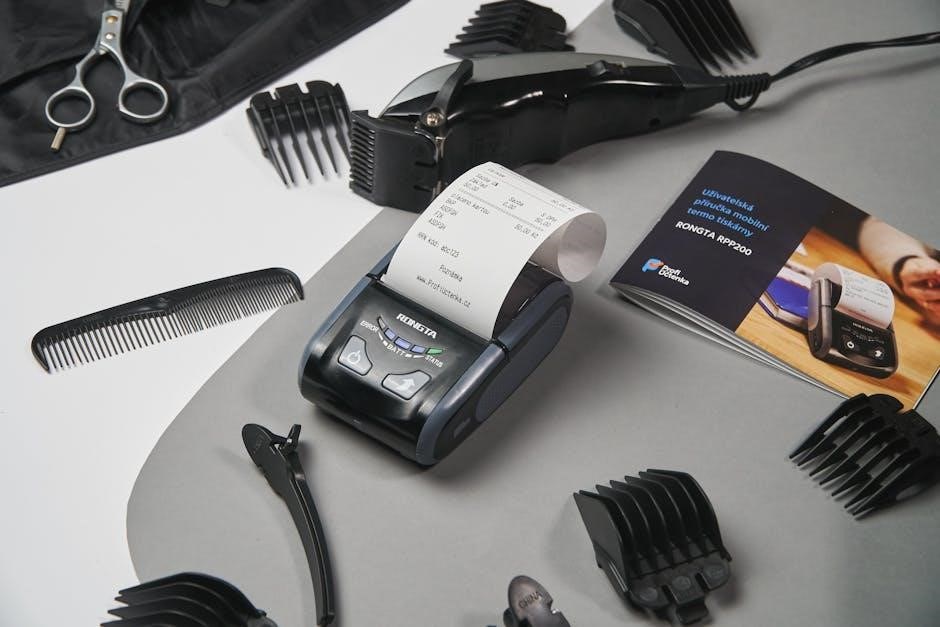Dog shock collar training, also known as e-collar training, uses electric stimulation to guide behavior. It is a method that, when used correctly, can improve the bond between owner and pet through effective communication and training.
Understanding the Basics of E-Collars
E-collars, or electronic collars, utilize mild electrical stimulation to gain a dog’s attention. These devices have evolved to offer various levels of stimulation, including tone and vibration. The goal is not to cause pain but to provide a clear signal during training; It is important to familiarize yourself with the device and its controls before use, ensuring a safe and effective learning experience for your dog.
Choosing the Right Shock Collar
Selecting a suitable shock collar involves considering your dog’s size, breed, and temperament. Look for collars with adjustable stimulation levels and durable, waterproof designs for effective training.
Selecting a Quality Product
When choosing a shock collar, prioritize reputable brands known for reliability and safety. Look for features like multiple stimulation levels, waterproof construction, and durable materials. A quality product ensures consistent performance and minimizes the risk of malfunction, which is crucial for effective and humane training. Consider models with long battery life and ergonomic designs for both you and your dog.
Features to Look For in a Collar
Essential features include adjustable stimulation levels to suit different dogs and training situations. A remote control with a good range is vital, along with a clear display. Look for a collar that offers multiple training modes, such as tone and vibration, in addition to static stimulation. Waterproof or water-resistant design is important for durability, and a secure, comfortable fit is essential for your dog’s safety.
Proper Fitting and Positioning
Correct fitting is crucial for consistent stimulation. The collar should be snug, allowing two fingers to fit underneath, and positioned high on the neck for optimal contact with the skin.
Ensuring Correct Collar Fit
A proper fit is essential for both effectiveness and comfort. The collar should be snug enough to make consistent contact with your dog’s skin, yet loose enough to allow two fingers to slide comfortably underneath. Avoid it being too tight which can cause irritation, or too loose, which may result in inconsistent stimulation and ineffective training. Regular checks and adjustments ensure the best fit.
Positioning for Consistent Stimulation
The collar should be positioned high on the dog’s neck, just behind the ears for optimal stimulation. Rotate the contact points to different areas of the neck during use to prevent irritation and maintain consistent contact with the skin. Proper placement ensures that the stimulation is delivered effectively, promoting reliable training results and avoiding discomfort for your dog.
Starting Shock Collar Training
Begin by gradually introducing the collar and start with the lowest stimulation level. Observe your dog’s reaction and adjust gradually. Consistency and patience are key to successful training outcomes.
Before using the stimulation, allow your dog to become comfortable wearing the collar for short periods each day. Associate the collar with positive experiences such as treats and praise. This helps prevent negative associations with the collar itself, making the training process much smoother and more effective when you begin using the stimulation features.
Finding the Appropriate Stimulation Level
Begin with the lowest stimulation setting and gradually increase it until your dog shows a mild reaction, such as a tensing of neck muscles. The goal is not to cause pain, but to get the dog’s attention. This level may vary depending on the training situation and the dog’s current level of distraction, adjust accordingly.
Training Techniques
Effective training combines the e-collar with positive reinforcement. Consistency and precise timing are critical. Use the lowest stimulation needed to gain your dog’s attention during training sessions.
Combining Shock with Positive Reinforcement
Integrating positive reinforcement with e-collar use is crucial for success. When your dog responds correctly to a command after a mild stimulation, immediately reward them with praise, treats, or a favorite toy. This approach helps your dog associate the desired behavior with positive outcomes, making the learning process more effective and less stressful. The shock should not be the primary motivator; rather, a gentle guide.
Consistency and Timing in Training
Consistent application of commands and corrections is vital for effective e-collar training. Deliver stimulation immediately when the dog makes an incorrect choice, and always follow through with the desired action. The timing of the shock and positive reinforcement should be precise. This helps the dog understand exactly what behavior is expected, and promotes clear communication. Inconsistency leads to confusion and undermines the training process.

Common Mistakes to Avoid
Misusing stimulation levels is a significant error; always start low and increase gradually. Avoid over-reliance on the shock, combine it with positive reinforcement, and be consistent with the timing of corrections.
Misuse of Stimulation Levels
A common mistake is using too high of a stimulation level from the outset, causing unnecessary pain and fear. Always begin at the lowest setting and gradually increase only until your dog shows a mild reaction, like a tensing of the neck muscles. Avoid going beyond this point, as it can lead to negative associations and hinder effective training. Adjust the level as needed for different situations, but always prioritize your dog’s comfort.
Avoiding Over-Reliance on Shock
Over-reliance on the shock function is a pitfall. The e-collar should not be the sole training method. Instead, combine it with positive reinforcement techniques like praise, treats, and play. Use the shock only as a correction, not as the primary way to communicate. Aim to eventually transition to using tone and vibration as communication tools. A balanced approach ensures a happy, well-adjusted dog.
Safety Precautions and Considerations
Avoid using shock collars on aggressive dogs, as it can worsen behavior. Always start at the lowest setting and consult with professionals for proper usage. Prioritize safety.
When NOT to use a Shock Collar
Avoid using shock collars on puppies, elderly dogs, or dogs with health issues. Never use them on fearful or aggressive dogs as it can exacerbate these behaviors. Do not use shock collars as a substitute for proper training. The training should be a positive experience for the dog, not one of fear and stress. Always prioritize humane and ethical training practices.
Addressing Aggressive Behaviors
Using a shock collar to address aggression is generally not recommended and can be dangerous. Aggression often stems from fear or anxiety, and punishment can worsen these feelings. Instead, seek help from a professional dog behaviorist. They can help identify the root cause of the aggression and develop a safe, effective training plan. Never use a shock collar to suppress aggression.
Alternatives to Shock Collars
Positive reinforcement methods, such as rewarding desired behaviors, offer effective, humane alternatives. Other training tools include clickers, harnesses, and specialized leashes. These methods focus on building positive associations and trust.
Exploring Positive Reinforcement Methods
Positive reinforcement focuses on rewarding desired behaviors with treats, praise, or toys. This method builds a strong bond with your dog, encouraging them to repeat good actions. It avoids the use of aversives, promoting a happy and willing learner. Consistency and patience are key to success with positive reinforcement. It’s an effective way to teach new tricks and manage behavior issues by focusing on what you want the dog to do;
Other Training Tools and Techniques
Beyond shock collars, various tools can aid dog training. These include clickers, which mark desired behaviors, and prong collars, used for communication through pressure. Head halters offer gentle control, while harnesses are great for leash training. Each tool requires proper understanding and application. Remember that consistent training is key, regardless of the method used. Exploring different tools may lead you to a better fit for your dogs’ specific needs and personality.

Brands and Models Overview
Popular brands like PetSpy, Dogtra and SportDOG offer various e-collar models. Each brand provides different features, ranges, and stimulation levels, catering to diverse training needs. Researching models is essential.
Popular E-Collar Brands
Several reputable brands dominate the e-collar market, including Dogtra, known for its high-quality and durable products, and SportDOG, which offers versatile systems suitable for various training scenarios. PetSpy provides more budget-friendly options, while Educator Collars are recognized for their gentle, low-level stimulation. Each brand caters to different needs, so selecting the right brand is crucial for effective training.
Specific Model Recommendations
For basic training, consider the SportDOG SD-425X or SD-825X, known for their reliability and ease of use. For more advanced training or working dogs, the Dogtra 1900S or 2300NCP offer enhanced features and greater range. The Educator ET-300 is a good option for those seeking a gentler approach. The Jugbow Dog Shock Collar is a budget-friendly option with multiple training modes. Always match the model to your dog’s specific needs and training goals.

E-Collar Training and Behavior Modification
E-collar training can help correct negative behaviors like excessive barking or jumping. It also helps improve performance in complex service roles. Using it consistently is key to success.
Correcting Negative Behavior
E-collars can be effective for addressing unwanted behaviors such as excessive barking, digging, or chasing. The stimulation helps interrupt the undesirable action, allowing you to redirect your dog towards a more acceptable behavior. Consistency and proper timing are critical when using an e-collar to correct negative habits. Always pair corrections with positive reinforcement for the best results. Gradual introduction is also key.
Improving Performance
Beyond correcting negative behaviors, e-collars can enhance performance in various activities, including obedience, agility, and service-oriented tasks. The precise communication offered by an e-collar can refine your dog’s understanding of commands and cues, leading to more accurate and reliable execution. This is particularly useful for advanced training where clear communication is critical. The use of low levels of stimulation, and positive reinforcement are key.
Professional Guidance
Seeking advice from a certified trainer is crucial for safe and effective e-collar use. Professional guidance ensures proper technique and helps avoid common mistakes for successful training outcomes.
Seeking Help from a Certified Trainer
Consulting a certified dog trainer is highly recommended before using a shock collar. A professional can guide you on proper fitting, stimulation levels, and training techniques. They will ensure you understand how to use the e-collar effectively and humanely, minimizing risks and maximizing positive outcomes for your dog’s behavior and well-being. Their expertise can prevent misuse and help create a strong training foundation.
The Importance of Expert Supervision
Expert supervision is crucial when using a shock collar. A qualified trainer provides valuable insights into canine behavior and can tailor training plans for your dog’s specific needs. Their guidance ensures you’re using the collar safely and effectively, helping to establish a positive learning environment; They can also identify potential issues early on and prevent the development of fear or anxiety in your dog during training.

Ethical Considerations and Controversies
The use of shock collars is controversial, with animal rights groups raising concerns about pain and distress; Many argue that positive reinforcement methods offer a more humane approach.
Debate Surrounding Shock Collar Use
The debate around shock collars centers on their potential for misuse and harm, with critics arguing they cause unnecessary pain and fear. Proponents, however, suggest that when used correctly, they can be effective and humane tools for training, particularly in situations where other methods may fail to provide the necessary correction for a dog’s behavior. The proper use is key.
Understanding Animal Rights Concerns
Animal rights concerns regarding shock collars stem from the belief that they inflict pain and can lead to psychological distress in dogs. Critics argue that using electric shocks for training is inherently inhumane and that positive reinforcement methods are more ethical and effective. These concerns highlight the importance of responsible and compassionate training practices that respect animal welfare, using less invasive methods.


